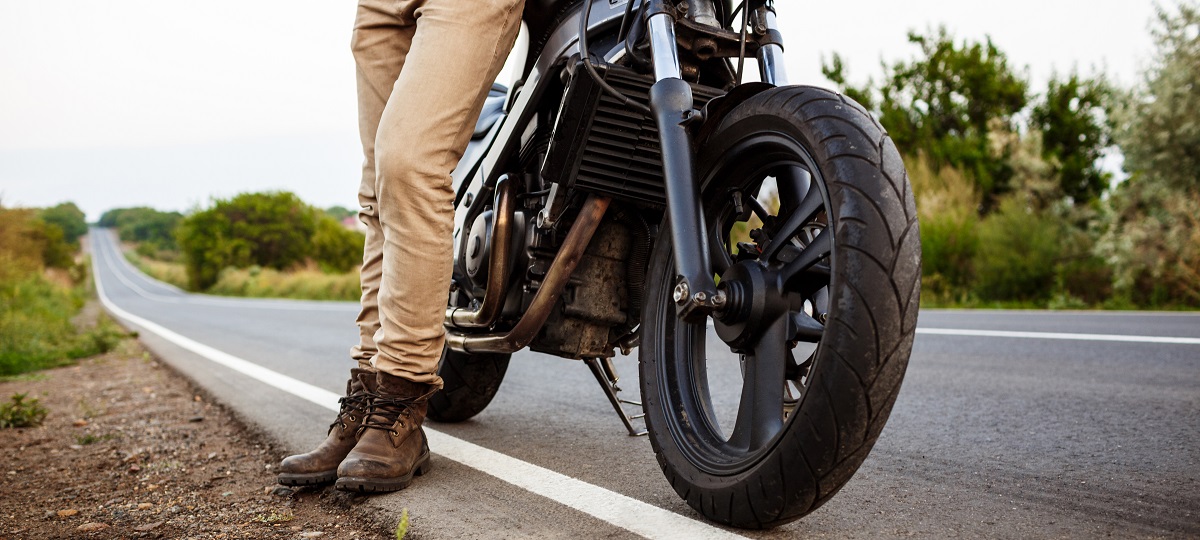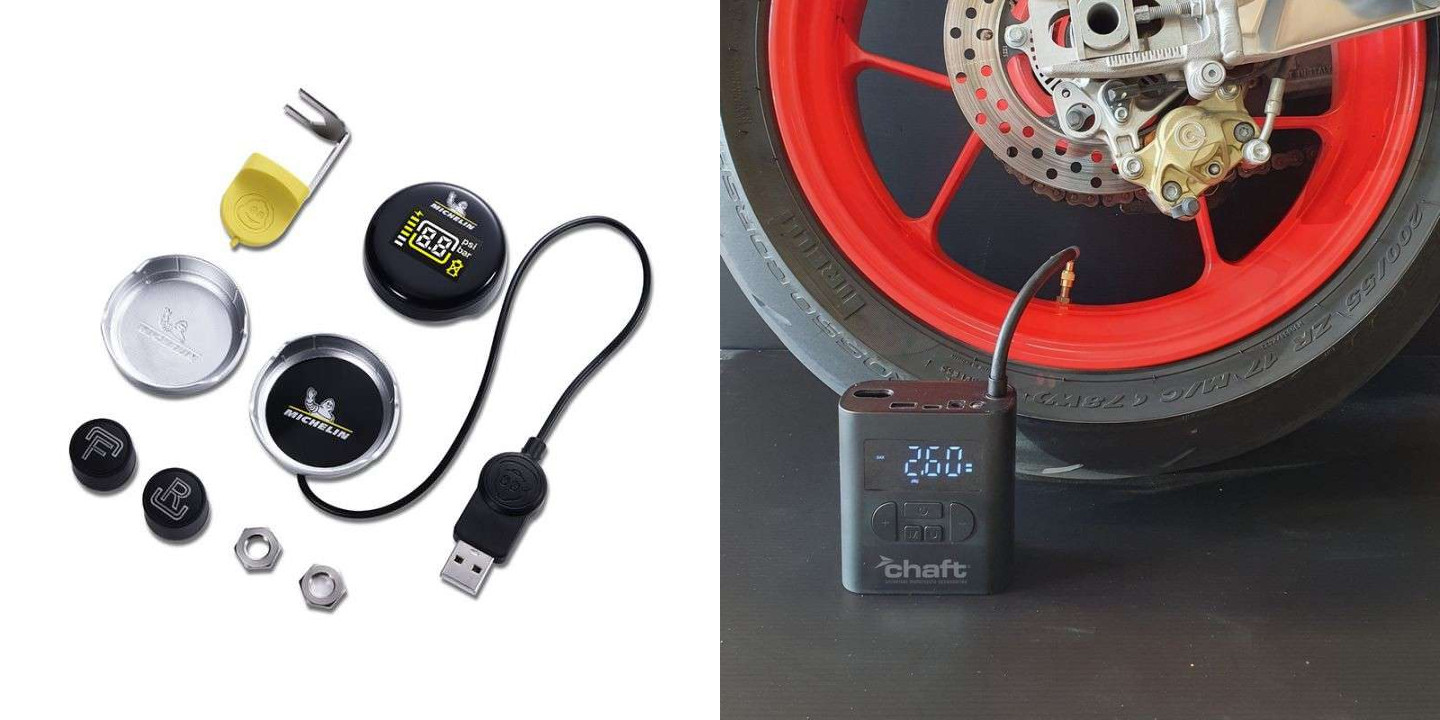
#pneumoto #entretienmoto #maintenancemoto
What's black, what's made of rubber and what provides the grip between your bike and the road? Well, "my shoes" is one answer, but in this article, we're going to focus on tires. As the only point of contact between your bike and the asphalt, you owe it to yourself to cherish them and maintain them with care. What should you check on your tires? How can you prolong their life? Here's our advice!
Basic motorcycle tire maintenance in 3 easy steps:
Checking the condition of your tires is as simple as it is crucial. But why? This quick inspection will enable you to detect an under-inflated tire, a rinsed rubber or a cracked sidewall. 3 points you can check in just 10 minutes. Top time!
![]()
How to check the tread wear on a motorcycle tire?
The surface of a tire is a clever patchwork of flat surfaces (in contact with the road) and grooves (to evacuate water). So, unless you live in the Chilean Atacama desert where it rains only 0.1mm a year, you need both. How to check tire wear? By inspecting the indicators. Marked by small triangles on the sidewall, these thickened areas in the grooves give an indication of the remaining rubber thickness. If the indicator is flush with the surface, it's time to change the tire. Why not use a slick tire? Firstly, because if you're going to be riding in the rain, you'll soon realize how useful those little grooves are for evacuating water. And secondly, it's illegal. That's right, a 90€ fine!
![]()
How do you check the condition of a motorcycle tire's outer surface?
Checking the condition of a tire is just as important as its wear. But what exactly should be checked? That the surface is smooth and even. If you notice any cracks, it's time for a new tire. Deformations or hernias are also a bad sign. Finally, look for any foreign bodies (nails, screws, 10 mm sockets, etc.). What to do if you find one? Leave it alone and go to your mechanic. And yeah, removing a tip can trigger a leak, so you might as well leave it alone.

![]()
How often should I check my motorcycle tire pressure?
The thing to remember? A tire is porous. It's not completely impermeable. So air escapes naturally. Hence the importance of regularly checking tire pressure (every 1,000 km or at least twice a month) with an accurate pressure gauge.
How does this affect your bike's handling? An under-inflated tire will wear out quickly, making your bike less stable and giving you a blurred feel when cornering. Over-inflation, on the other hand, can lead to uneven wear and, above all, a loss of grip. And yes, the more the tire is inflated, the smaller the surface area in contact with the road.
What pressure should I choose? The pressure recommended by the manufacturer. Note that it's best to measure cold!
How do you break in new motorcycle tires?
How do you easily unmould a chocolate cake? By buttering the mold, of course! Tire manufacturers used exactly the same method to form their gumshoes, except that they spread them with kerosene. This explains why a new tire had a certain propensity to slip during the first few kilometers. Why talk about the past? Because nowadays, Michelin, Heidenau and Pirelli use new fats that are much less unpleasant than that damned kerosene. However, even today, a running-in period is necessary to get the best performance from your tire. How should you behave? The same as when you're driving in the rain. Quite simply! Moderate acceleration, progressive cornering, anticipatory braking: nothing too complicated. A hundred kilometers or so of hard riding will be enough to unleash the full potential of your tire.
How can I extend the life of my motorcycle tires?
That's right, at an average of €150 per tire, you might as well put off changing them as long as possible. We'll give you all the levers you need!
![]()
Tire pressure
As we saw earlier, optimum inflation is crucial. So, if you're an afficionado of ideal pressure, you can opt for Michelin's TPMS. The Touche-Pas-à-Mon-Slip? Niet! The Tire Pressure Monitoring System. Easy to install, this ingenious tool lets you know the pressure of your tires in real time. Combined with a stand-alone compressor, it's the ideal combo for heavy-duty drivers.

----> Michelin TPMS tire pressure monitoring system
----> Chaft SMART PUMP II self-contained wireless compressor
![]()
Tire quality
Of course, not all brands are created equal. And yes, tire development is a science. It has to combine grip and longevity with maximum water evacuation. Which brand to choose? Which model to choose? Our Ixtem Moto team is here to advise you.
![]()
The ride
At the risk of surprising you, burns, skids and slides have a slight tendency to reduce the life of your tire. But even without going to these extremes, the way you ride has an impact on the life of your rubber. The more moderate your acceleration and braking, the longer your tires will last.
![]()
Good suspension and rim balancing
The role of your shock absorbers is simple: to guarantee permanent contact between the tire and the road. They must therefore be supple enough to smooth out the roughness of the road, but rigid enough not to sink in under every acceleration or braking action. Your role in this? Make sure they're in good condition, in particular by checking for leaks (a sign of dead spinnaker seals). What's more, an unbalanced rim can vibrate. Obviously, this will overload the suspension, but it also wears out the tires prematurely.
![]()
Tire profile
A studded tire on a trail bike has a lot to live up to. But in addition to not gripping as well on wet roads, it will wear out faster than its road-typed counterpart. And yeah, the more studs you have, the smaller the surface area in contact with the wheel. It's a bit like Swiss cheese. The more cheese you have, the more holes you have, the less cheese you have. The same goes for tires: the more studs you have, the less studs they have. CQFD!
How to store motorcycle tires?
You've found a good deal on tires on the Internet, but you don't need them right away? There are a few precautions you can take to store your gumshoes for a few months.![]()
Rimless tires
We recommend storing them upright. This is the best way to limit possible deformation. What to avoid? Hanging them up or stacking them. This could damage sensitive surfaces, such as the seal between tire and rim on tubeless models.
![]()
Tire on rim
In this case, the opposite is true. Stacking or hanging them up is fine. Why not put them on vertically? Because, in the long term, the weight of the rim could deform the contact area.
Now you know everything there is to know about tire maintenance. What's the most important thing to remember? Tires are the only point of contact with the wheel. So you need to cherish them, inspect them regularly and be on the lookout for the slightest defect. With that, all we have to say is bon voyage!

Our last posts
#interviewmotarde #etonvaoumaintenant #motardevoyageuse #voyagemoto
#hivernale #millevaches #équipementmotard #aventuresmichel
#aventuresmichel #hardefitour #raidenduro #tout-terrain
Aucun produit
